Hudson River Almanac 6/30/18 - 7/6/18
The New York State Department of Environmental Conservation sent this bulletin on 07/13/2018 02:00 PM EDT |
| DEC Delivers - Information to keep you connected and informed from the NYS Department of Environmental Conservation |
| Share or view as a web page || Update preferences or unsubscribe |
|
|
OVERVIEW The first six days of this week were tropical as air temperatures of 90 degrees Fahrenheit (F) and more reached every corner of the watershed with many one-day record highs. Many educators with sampling nets took to the tepid waters of the Hudson (15 degrees cooler) to see what was home. HIGHLIGHT OF THE WEEK
[Note: one inch = 25.4 millimeters (mm)] [Atlantic needlefish (Strongylura marina) are a salt-to-brackish water species that has been able to adapt to inshore waters. Defying their literature, they are now spawning in freshwater. A good indication as to how dynamic their presence has been in the estuary, in his Biological Survey of the Lower Hudson Watershed (1937), J.R. Greeley refers to Atlantic needlefish as “rare,” and notes that they “spawn in saltwater.” Needlefish are often found on the surface where they do line-of-sight predation with their long, tooth-studded jaws. They have a ventrally-adjusted lateral line that allows them to be directly on top and still maintain an air/water interface. Tom Lake] NATURAL HISTORY ENTRIES
[The DEC released a Guidance to Homeowners on how to avoid problems with black bears. http://www.dec.ny.gov/press/113258.html] 6/30 – Town of Poughkeepsie: With the air temperature at 92 degrees F, and a warm southwest breeze, there was no shortage of thermals for the birds from bald eagle nest NY62. One of the two immatures soared over a ridge line above the nest tree, escorted by a red-tailed hawk – the local red-tails do not fully trust the larger raptors. The second immature eagle drifted along the river above the railroad tracks. Held up by thermals and the breeze, it found no need to flap its wings.
6/30 – Yonkers, HRM 18: We held our River Explorers Program today with children and their parents at the Sarah Lawrence Center for the Urban River at Beczak. Although the air temperature was 96 degrees F, the students were all smiles. [This would be the first of six consecutive days of greater than 90 degrees F]. It was high tide so we went seining in the marsh and altogether we caught blue crabs, moon jellyfish, an Asian shore crab, bay anchovies, and eighteen YOY mummichogs (20-30 mm). [The Asian shore crab (Hemigrapsus sanguineus) is an invasive species that likely arrived in the United States in the ballast of cargo ships. It is native to the inshore ocean areas around China and Japan. The Asian shore crab favors rocky intertidal areas and occupies similar habitats and competes with our native mud crabs (Panopeidae). Adults can grow to 42 millimeters (mm) carapace width. Tom Lake] 7/1 – Newcomb, HRM 302: The air temperature reached 92 degrees F today, a record high for the date by nine degrees. 7/1 – Greene County: I paddled my kayak across the river this evening to see if the nestling I reported in bald eagle nest NY203 on the last day of May was still there. The nest was empty, but two adults, probably those from NY203, were perched on a shoreline branch 100 yards distant. One of the two was banded, but I was unable to see any numbers. Directly across the river from NY203, I came upon a perched immature eagle being harassed by red-winged blackbirds. This may have been the missing nestling, now a fledgling. [In recent years, one of the adults in bald eagle nest NY203 had carried a blue DEC band number K96. This eagle was born in a nest (NY12) at Pepacton Reservoir in the Catskill Mountains of Delaware County in April 2000. Tom Lake]
[Eurasian water chestnut (Trapa natans) is an invasive, floating-leaved aquatic plant native to Eurasia and Africa. The species has been present in the watershed since it was intentionally introduced into Sander’s Lake (now Collins Lake in Scotia, Schenectady County) in 1884. In many places it has out-competed native aquatic vegetation, especially in bays, marshes, and in tributaries. Water chestnut grows in waters 0.3 to 3.6 m deep but is most abundant in sheltered bodies of water about 2.0 m deep with soft, muddy bottoms. Water chestnut is restricted to fresh waters because its seeds fail to germinate in brackish to salt water. As a result, it is rarely found in the lower estuary below the Hudson Highlands. For a detailed look at Trapa natans, see Hummel and Kiviat (2004) Review of World Literature on Water Chestnut with Implications for Management in North America http://aquaticcommons.org/1664/1/water_chestnut.pdf Tom Lake] 7/1 – Yonkers, HRM 18: The air temperature reached 97 degrees F today, tying the record high for the date. 7/2 – Newcomb, HRM 302: The air temperature reached 91 degrees F today, a record high for the date by seven degrees. 7/2 – Greene County, HRM 113: I spotted my first monarch butterfly today near the west end of the Rip Van Winkle Bridge. 7/2 – Town of Poughkeepsie: It is common to see red-winged blackbirds interacting with bald eagles, frequently harassing new fledglings. Today, however, as one of the two immatures from bald eagle nest NY62 flew toward the nest tree, a male red-winged blackbird was calmly riding on its back. 7/2 – Manhattan, HRM 1: We braved the sweltering heat to check our research sampling gear in Hudson River Park at The River Project's sampling station on the lighthouse tender Lilac at Pier 25. The payoff included pots and traps brimming with fish. We counted nine tautog (275-310 mm), four oyster toadfish (50-205 mm), a lined sea horse (70 mm), and a northern pipefish (200 mm). Among the fish we also found two spider crabs (60 mm). 7/3 – Newcomb, HRM 302: The air temperature reached 91 degrees F today, a record high for the date by four degrees. 7/3 – Stanfordville, HRM 84: The two nestlings at bald eagle nest NY487 had been actively exploring the nest tree for about a week, but this morning, I could not find one of them. I wondered if it had fledged until I heard both of them vocalizing.
7/3 – Newburgh, HRM 61: One of the new (for 2018) bald eagle nests (NY488) has had wonderful success with two nestlings that may have, by now, become fledglings. They looked full size and ready today, perched together on a limb of the nest tree. It is common for new pairs to not have much luck their first year until they learn from experience, but this pair got it right. (There is also the possibility that this pair had moved from another nest location.)
On this sultry summer day (the air temperature at 95 degrees F) the role of the estuary as a nursery for young-of-the-season fishes was never more evident. As we hauled our seine up on the sand, we found hundreds of silvery fishes of nine species. High count by far went to YOY blueback herring (42-64 mm). Other YOY with a significant presence included striped bass (22-46 mm), Atlantic menhaden (46-77 mm), bluefish (69-87 mm), and channel catfish (85-89 mm). The river was 75 degrees F and the salinity was 2.0 parts-per-thousand (ppt). (Photo of seining courtesy of Phyllis Lake) [Seines are commonly mentioned in Almanac observations pertaining to fisheries research and education. A seine is a net with a float-line on top, a lead-line on the bottom, and tight meshes in between. The word seine is French, from the Latin sagëna, which means a fishing net designed to hang vertically in the water, the ends of which are drawn together to enclose the fish. Those referenced in the Almanac range in length from 15-to-200-feet-long, four-to-eight-feet in depth, and mesh size from quarter-inch to three-inches depending upon the target fish. They are an excellent tool, used to sample an area and collect aquatic animals without injuring the catch. Haul seines, long nets that required a boat to set them and many strong arms to help haul in, were used in Hudson River commercial fishing from Colonial times until the last decade of the 20th century. They have since been outlawed; in the hands of competent fishers, they are simply too efficient. Tom Lake] 7/4 – Newcomb, HRM 302: The air temperature reached 91 degrees F today, tying the record high for the date. It was the fourth consecutive day of greater than 90 degrees. 7/4 – North Germantown, HRM109: A frisky and inquisitive red fox visited our yard today. It was surely aware that I was on the rear deck, but didn't seemed concerned, and didn't run off when I noisily went inside for my camera. It was late in the day and the low-angle sun nicely enhanced the fox's ruddy coloring. It stayed for about 10 minutes, and then casually slipped back into the woods.
[Since mushrooms are not difficult to find once you learn where to look, Steve's exact locations are left vague. It is not unlike disclosing your favorite fishing hole and finding that visitors have come and taken all the “big ones.” The satisfaction comes from finding your own fishing hole. Tom Lake] [Eating some species of wild mushrooms can cause sickness and even death. Despite widespread beliefs to the contrary, there is no general rule that allows you to distinguish between a poisonous mushroom and one that is safe to eat. Wild mushrooms should only be considered for consumption after being identified by an expert mycologist and even then, only in moderation with samples of fresh specimens retained and properly stored to aid in identification whenever poisoning is considered a possibility. Joining a mushroom club and participating in lectures, forays and mushroom identification classes is an excellent way to begin to learn all that needs to be known before you should feel that you can competently and independently identify a mushroom as being safe and edible 100% of the time. Steve Rock] 7/5 – Beacon, HRM 61: For the sixth straight day, air temperatures exceeded 90 degrees F, from the High Peaks of the Adirondacks to the sea. By comparison, the 81 degree Hudson River felt refreshing with a sight tang of salt at 2.0 ppt. YOY fishes again dominated our catch, so much so that we left the seine in a few inches of water, measured some, estimated their numbers, and returned as many as we could. As we expected, blueback herring (46-56 mm) was high catch along with striped bass (32-47 mm). 7/5 – Yonkers, HRM 18: Today’s intern training program at the Sarah Lawrence College Center for the Urban River at Beczak included seining at high tide in the Beczak marsh. In six hauls we caught Atlantic silverside, mummichogs, moon jellyfish, shore shrimp, and two YOY striped bass. 7/5 – Manhattan, HRM 1: We checked our research sampling gear in Hudson River Park at The River Project's sampling station on the lighthouse tender Lilac at Pier 25. We found that overnight, we had caught, eight tautog (175-280 mm), an oyster toadfish (205 mm), and a YOY blue crab (15 mm).
[The red eft is the juvenile life form of the eastern red-spotted newt (Notophthalmus viridescens), a widespread and native salamander. Tom Lake]
Free Trees for Streamside Planting For more information about the program or to download an application, please visit the DEC website at: www.dec.ny.gov/lands/43668.html . If you have questions about a potential planting site, please contact Beth Roessler at (845) 256-2253 or HudsonEstuaryTFT@dec.ny.gov. The Hudson is measured north from Hudson River Mile 0 at the Battery at the southern tip of Manhattan. The George Washington Bridge is at HRM 12, the Tappan Zee 28, Bear Mountain 47, Beacon-Newburgh 62, Mid-Hudson 75, Kingston-Rhinecliff 95, Rip Van Winkle 114, and the Federal Dam at Troy, the head of tidewater, at 153. The tidal section of the Hudson constitutes a bit less than half the total distance – 315 miles – from Lake Tear of the Clouds to the Battery. Entries from points east and west in the watershed reference the corresponding river mile on the mainstem. TO CONTRIBUTE YOUR OBSERVATIONS OR TO SUBSCRIBE The Hudson River Almanac is compiled and edited by Tom Lake and emailed weekly by DEC's Hudson River Estuary Program. Share your observations by e-mailing them to trlake7@aol.com. To subscribe to the Almanac (or to unsubscribe), use the links on DEC's Hudson River Almanac or DEC Delivers web pages. Discover New York State Conservationist - the award-winning, advertisement-free magazine focusing on New York State's great outdoors and natural resources. Conservationist features stunning photography, informative articles and around-the-state coverage. Visit the Conservationist webpage for more information. USEFUL LINKS National Oceanic and Atmospheric Administration online tide and tidal current predictions are invaluable when planning Hudson River field trips. For real-time information on Hudson River tides, weather and water conditions from sixteen monitoring stations, visit the Hudson River Environmental Conditions Observing System website. NY Open for Hunting and Fishing Initiative: Under Governor Cuomo's Adventure NY initiative, DEC is making strategic investments to expand access to healthy, active outdoor recreation, connect more New Yorkers and visitors to nature and the outdoors, protect natural resources, and boost local economies. This initiative will support the completion of more than 75 projects over the next three years, ranging from improvements to youth camps and environmental education centers to new boat launches, duck blinds, and hiking trails. Read more about the Adventure NY initiative. For more information on planning an outdoor adventure in New York State, visit DEC's website at http://www.dec.ny.gov/outdoor. Information about the Hudson River Estuary Program is available on DEC's website at http://www.dec.ny.gov/lands/4920.html. Copies of past issues of the Hudson River Almanac, Volumes II-VIII, are available for purchase from the publisher, Purple Mountain Press, (800) 325-2665, or email purple@catskill.net |

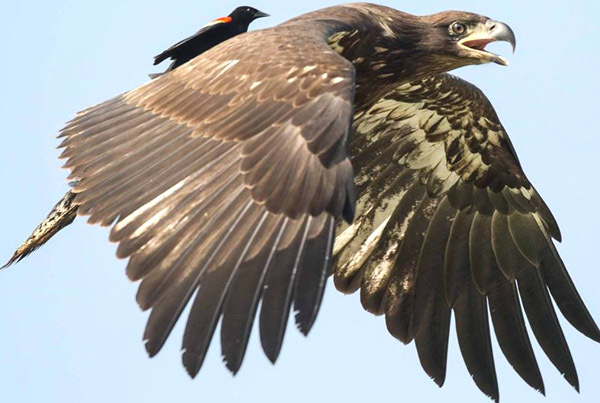 Hudson River Almanac
Hudson River Almanac 7/5 – Stockport, HRM 122: We seined at the Stockport Middle Grounds this morning with Marist college students. Our catch included some beautiful banded killifish in breeding colors, a few mummichogs, and young-of-the-year (YOY) striped bass. However, the highlight was two YOY Atlantic needlefish, each about 63 millimeters (mm). (Photo of Atlantic needlefish courtesy of NJDEP)
7/5 – Stockport, HRM 122: We seined at the Stockport Middle Grounds this morning with Marist college students. Our catch included some beautiful banded killifish in breeding colors, a few mummichogs, and young-of-the-year (YOY) striped bass. However, the highlight was two YOY Atlantic needlefish, each about 63 millimeters (mm). (Photo of Atlantic needlefish courtesy of NJDEP)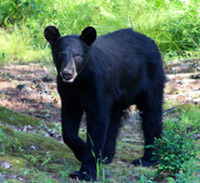 6/30 – Ulster County, HRM 76: A young black bear visited us this evening in Kerhonkson just as we were setting up for a backyard barbecue. The bear was not concerned by our Labrador retriever’s barking, and after a short while, the bear just calmly sauntered off. (Photo of black bear courtesy of Jeremy Baracca)
6/30 – Ulster County, HRM 76: A young black bear visited us this evening in Kerhonkson just as we were setting up for a backyard barbecue. The bear was not concerned by our Labrador retriever’s barking, and after a short while, the bear just calmly sauntered off. (Photo of black bear courtesy of Jeremy Baracca)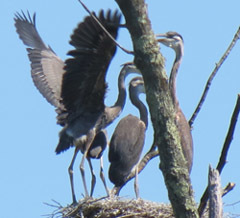 6/30 – Bedford, HRM 35: It was a very hot day at the great blue heron rookery (96 degrees F). The nestlings were panting very fast to keep cool. One heron nestling had fledged and was perched in a nearby tree. It beat its wings at times, but did not seem inclined to go back to its nest. I was sure that when a parent arrived with food it would. Another nest had just a single nestling, so I guessed that its sibling had fledged and might now be with a parent learning to hunt for its own food. There were two other nests with a nestling in each, flapping their wings. In a day or so they very likely will have fledged as well. (Photo of great blue heron nestlings courtesy of Jim Steck)
6/30 – Bedford, HRM 35: It was a very hot day at the great blue heron rookery (96 degrees F). The nestlings were panting very fast to keep cool. One heron nestling had fledged and was perched in a nearby tree. It beat its wings at times, but did not seem inclined to go back to its nest. I was sure that when a parent arrived with food it would. Another nest had just a single nestling, so I guessed that its sibling had fledged and might now be with a parent learning to hunt for its own food. There were two other nests with a nestling in each, flapping their wings. In a day or so they very likely will have fledged as well. (Photo of great blue heron nestlings courtesy of Jim Steck)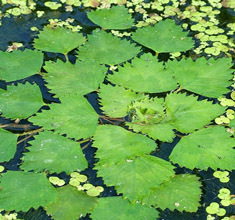 7/1 – Poughkeepsie to New Hamburg, HRM 75-67: Our fifteen-minute, eight-mile Metro-North train ride gave us an excellent opportunity to see what birds were using the green border of water chestnut extending out from the shoreline. In most places, the heavily matted vegetation was 50-200 meters (m) wide and looked firm enough to walk on, if you were a wading bird. Our count was headed by two-dozen double-crested cormorants followed by 16 great blue herons, six green herons, four Canada geese, and one black-crowned night heron. Out on the edge, we also saw too-many-to-count mallards, mostly hens. (Photo of eurasian water chestnut courtesy of Tom Lake)
7/1 – Poughkeepsie to New Hamburg, HRM 75-67: Our fifteen-minute, eight-mile Metro-North train ride gave us an excellent opportunity to see what birds were using the green border of water chestnut extending out from the shoreline. In most places, the heavily matted vegetation was 50-200 meters (m) wide and looked firm enough to walk on, if you were a wading bird. Our count was headed by two-dozen double-crested cormorants followed by 16 great blue herons, six green herons, four Canada geese, and one black-crowned night heron. Out on the edge, we also saw too-many-to-count mallards, mostly hens. (Photo of eurasian water chestnut courtesy of Tom Lake)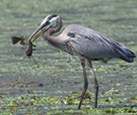 7/3 – Town of Poughkeepsie, HRM 68: There is a small one acre pond just upland off the river that attracts great blue herons, probably for the ease of catching large but slow-moving fish. I have witnessed several times as herons snatched fish from shallows half-filled with aquatic vegetation. Today it was a brown bullhead. (Photo of great blue heron with brown bullhead courtesy of Terry Hardy)
7/3 – Town of Poughkeepsie, HRM 68: There is a small one acre pond just upland off the river that attracts great blue herons, probably for the ease of catching large but slow-moving fish. I have witnessed several times as herons snatched fish from shallows half-filled with aquatic vegetation. Today it was a brown bullhead. (Photo of great blue heron with brown bullhead courtesy of Terry Hardy) 7/3 – Little Stony Point, HRM 55: This little peninsula, part of the Hudson Highlands State Park 66 miles upriver from the open sea, never fails to please. Even if wildlife is scarce, the views of the Hudson Highlands, from Crow’s Nest to Storm King to Breakneck Ridge to Mount Taurus, are always exquisite.
7/3 – Little Stony Point, HRM 55: This little peninsula, part of the Hudson Highlands State Park 66 miles upriver from the open sea, never fails to please. Even if wildlife is scarce, the views of the Hudson Highlands, from Crow’s Nest to Storm King to Breakneck Ridge to Mount Taurus, are always exquisite. 7/4 – Westchester Country: We began our Independence Day with plans to discover whether or not the recent rains and hot weather had brought up the chanterelles [mushrooms] in our regular spots. This took us to our favorite northern Westchester park. There was a smattering of the usual wood-rotting fungi and a couple of Russulas and Amanitas, but the Boletus sensibilis that we've found there in big numbers in previous years were fruiting just enough to satisfy the squirrels, chipmunks and snails so we left them. No chanterelle were found. (Photo of mushroom courtesy of Steve Rock)
7/4 – Westchester Country: We began our Independence Day with plans to discover whether or not the recent rains and hot weather had brought up the chanterelles [mushrooms] in our regular spots. This took us to our favorite northern Westchester park. There was a smattering of the usual wood-rotting fungi and a couple of Russulas and Amanitas, but the Boletus sensibilis that we've found there in big numbers in previous years were fruiting just enough to satisfy the squirrels, chipmunks and snails so we left them. No chanterelle were found. (Photo of mushroom courtesy of Steve Rock) 7/6 – Hamilton County, HRM 208: Sometimes salamanders are few and far between, and at those times I wonder where they've disappeared to. That was not the case this morning when we did some hiking in the Town of Hope (Sacandaga River watershed). The trail, winding through a mixed hardwood and conifer forest, was a festival of red efts. We saw about 50 of them, just on the trail – it had rained overnight, and these newts seemed very happy. Inspired, we lifted a few logs and found a couple of red-backed salamanders as well. We also found a spectacular round-leaved orchid (Platanthera orbiculata) right alongside the trail. These are a species of orchid native to forested areas of North America. (Photo of round leaved orchid courtesy of Mike Corey)
7/6 – Hamilton County, HRM 208: Sometimes salamanders are few and far between, and at those times I wonder where they've disappeared to. That was not the case this morning when we did some hiking in the Town of Hope (Sacandaga River watershed). The trail, winding through a mixed hardwood and conifer forest, was a festival of red efts. We saw about 50 of them, just on the trail – it had rained overnight, and these newts seemed very happy. Inspired, we lifted a few logs and found a couple of red-backed salamanders as well. We also found a spectacular round-leaved orchid (Platanthera orbiculata) right alongside the trail. These are a species of orchid native to forested areas of North America. (Photo of round leaved orchid courtesy of Mike Corey)